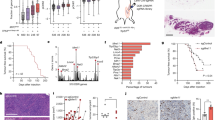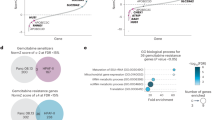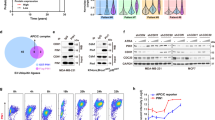Abstract
Infection with Helicobacter pylori cagA-positive strains is associated with gastric adenocarcinoma. Intestinal metaplasia is a precancerous lesion of the stomach characterized by transdifferentiation of the gastric mucosa to an intestinal phenotype. The H. pylori cagA gene product, CagA, is delivered into gastric epithelial cells, where it undergoes tyrosine phosphorylation by Src family kinases. Tyrosine-phosphorylated CagA specifically binds to and activates SHP-2 phosphatase, thereby inducing cell-morphological transformation. We report here that CagA physically interacts with E-cadherin independently of CagA tyrosine phosphorylation. The CagA/E-cadherin interaction impairs the complex formation between E-cadherin and β-catenin, causing cytoplasmic and nuclear accumulation of β-catenin. CagA-deregulated β-catenin then transactivates β-catenin-dependent genes such as cdx1, which encodes intestinal specific CDX1 transcription factor. In addition to β-catenin signal, CagA also transactivates p21WAF1/Cip1, again, in a phosphorylation-independent manner. Consequently, CagA induces aberrant expression of an intestinal-differentiation marker, goblet-cell mucin MUC2, in gastric epithelial cells that have been arrested in G1 by p21WAF1/Cip1. These results indicate that perturbation of the E-cadherin/β-catenin complex by H. pylori CagA plays an important role in the development of intestinal metaplasia, a premalignant transdifferentiation of gastric epithelial cells from which intestinal-type gastric adenocarcinoma arises.
This is a preview of subscription content, access via your institution
Access options
Subscribe to this journal
Receive 50 print issues and online access
$259.00 per year
only $5.18 per issue
Buy this article
- Purchase on Springer Link
- Instant access to full article PDF
Prices may be subject to local taxes which are calculated during checkout





Similar content being viewed by others
References
Amieva MR, Vogelmann R, Covacci A, Tompkins LS, Nelson WJ, Falkow S . (2003). Disruption of the epithelial apical–junctional complex by Helicobacter pylori CagA. Science 300: 1430–1434.
Bailey T, Biddlestone L, Shepherd N, Barr H, Warner P, Jankowski J . (1998). Altered cadherin and catenin complexes in the Barrett's esophagus–dysplasia–adenocarcinoma sequence: correlation with disease progression and dedifferentiation. Am J Pathol 152: 135–144.
Bebb JR, Leach L, Zaitoun A, Hand N, Letley D, Thomas R et al. (2006). Effect of Helicobacter pylori on the cadherin–catenin complex. J Clin Pathol 59: 1261–1266.
Berx G, Becker K-F, Höfler H, van Roy F . (1998). Mutations of the human E-cadherin (CDH1) gene. Hum Mutat 12: 226–237.
Bierie B, Nozawa M, Renou JP, Shillingford JM, Morgan F, Oka T et al. (2003). Activation of β-catenin in prostate epithelium induces hyperplasias and squamous transdifferentiation. Oncogene 22: 3875–3887.
Blache P, van de Wetering M, Duluc I, Domon C, Berta P, Freund J-N et al. (2004). SOX9 is an intestine crypt transcription factor, is regulated by the Wnt pathway, and represses the CDX2 and MUC2 genes. J Cell Biol 166: 37–47.
Blaser MJ, Perez-Perez GI, Kleanthous H, Cover TL, Peek RM, Chyou PH et al. (1995). Infection with Helicobacter pylori strains possessing cagA is associated with an increased risk of developing adenocarcinoma of the stomach. Cancer Res 55: 2111–2115.
Churin Y, Al-Ghoul L, Kepp O, Meyer TF, Birchmeier W, Naumann M . (2003). Helicobacter pylori CagA protein targets the c-Met receptor and enhances the motogenic response. J Cell Biol 161: 249–255.
Duman-Scheel M, Johnston LA, Du W . (2004). Repression of dMyc expression by Wingless promotes Rbf-induced G1 arrest in the presumptive Drosophila wing margin. Proc Natl Acad Sci USA 101: 3857–3862.
Franco AT, Israel DA, Washington MK, Krishna U, Fox JG, Rogers AB et al. (2005). Activation of β-catenin by carcinogenic Helicobacter pylori. Proc Natl Acad Sci USA 102: 10646–10651.
Gavert N, Conacci-Sorrell M, Gast D, Schneider A, Altevogt P, Brabletz T et al. (2005). L1, a novel target of β-catenin signaling, transforms cells and is expressed at the invasive front of colon cancers. J Cell Biol 168: 633–642.
Giles RH, van Es JH, Clevers H . (2003). Caught up in a Wnt storm: Wnt signaling in cancer. Biochim Biophys Acta 1653: 1–24.
Guilford P, Hopkins J, Harraway J, McLeod M, McLeod N, Harawira P et al. (1998). E-cadherin germline mutations in familial gastric cancer. Nature 392: 402–405.
Guo R-J, Suh ER, Lynch JP . (2004). The role of Cdx proteins in intestinal development and cancer. Cancer Biol Ther 3: 593–601.
Hatakeyama M . (2004). Oncogenic mechanisms of the Helicobacter pylori CagA protein. Nat Rev Cancer 4: 688–694.
He T-C, Sparks AB, Rago C, Hermeking H, Zawel L, da Costa LT et al. (1998). Identification of c-MYC as a target of the APC pathway. Science 281: 1509–1512.
Higashi H, Nakaya A, Tsutsumi R, Yokoyama K, Fujii Y, Ishikawa S et al. (2004). Helicobacter pylori CagA induces Ras-independent morphogenetic response through SHP-2 recruitment and activation. J Biol Chem 279: 17205–17216.
Higashi H, Tsutsumi R, Muto S, Sugiyama T, Azuma T, Asaka M et al. (2002). SHP-2 tyrosine phosphatase as an intracellular target of Helicobacter pylori CagA protein. Science 295: 683–686.
Johnston LA, Edgar BA . (1998). Wingless and Notch regulate cell-cycle arrest in the developing Drosophila wing. Nature 394: 82–84.
Kenny PA, Enver T, Ashworth A . (2005). Receptor and secreted targets of Wnt-1/β-catenin signaling in mouse mammary epithelial cells. BMC Cancer 5: 3.
Kioussi C, Briata P, Baek SH, Rose DW, Hamblet NS, Herman T et al. (2002). Identification of a Wnt/Dvl/β-Catenin → Pitx2 pathway mediating cell-type-specific proliferation during development. Cell 111: 673–685.
Knudsen S . (2002). A Biological Guide to Analysis of DNA Microarray Data. John Wiley & Sons Inc.: New York.
Kuipers EJ, Perez-Perez GI, Meuwissen SGM, Blaser MJ . (1995). Helicobacter pylori and atrophic gastritis: importance of the cagA status. J Natl Cancer Inst 87: 1777–1780.
Lickert H, Domon C, Huls G, Wehrle C, Duluc I, Clevers H et al. (2000). Wnt/β-catenin signaling regulates the expression of the homeobox gene Cdx1 in embryonic intestine. Development 127: 3805–3813.
Mimuro H, Suzuki T, Tanaka J, Asahi M, Haas R, Sasakawa C . (2002). Grb2 is a key mediator of Helicobacter pylori CagA protein activities. Mol Cell 10: 745–755.
Miyoshi K, Shillingford JM, Le Provost F, Gounari F, Bronson R, von Boehmer H et al. (2002). Activation of β-catenin signaling in differentiated mammary secretory cells induces transdifferentiation into epidermis and squamous metaplasias. Proc Natl Acad Sci USA 99: 219–224.
Mizoshita T, Inada K, Tsukamoto T, Nozaki K, Joh T, Itoh M et al. (2004). Expression of the intestine-specific transcription factors, Cdx1 and Cdx2, correlates shift to an intestinal phenotype in gastric cancer cells. J Cancer Res Clin Oncol 130: 29–36.
Mutoh H, Sakurai S, Satoh K, Osawa H, Hakamata Y, Takeuchi T et al. (2004). Cdx1 induced intestinal metaplasia in the transgenic mouse stomach: comparative study with Cdx2 transgenic mice. Gut 53: 1416–1423.
Odenbreit S, Püls J, Sedlmaier B, Gerland E, Fischer W, Haas R . (2000). Translocation of Helicobacter pylori CagA into gastric epithelial cells by type IV secretion. Science 287: 1497–1500.
Okubo T, Hogan BLM . (2004). Hyperactive Wnt signaling changes the developmental potential of embryonic lung endoderm. J Biol 3: 11.1–11.17.
Parsonnet J, Friedman GD, Orentreich N, Vogelman H . (1997). Risk for gastric cancer in people with CagA positive or CagA negative Helicobacter pylori infection. Gut 40: 297–301.
Pinto D, Gregorieff A, Begthel H, Clevers H . (2003). Canonical Wnt signals are essential for homeostasis of the intestinal epithelium. Genes Dev 17: 1709–1713.
Segal ED, Cha J, Lo J, Falkow S, Tompkins LS . (1999). Altered states: involvement of phosphorylated CagA in the induction of host cellular growth changes by Helicobacter pylori. Proc Natl Acad Sci USA 96: 14559–14564.
Silberg DG, Furth EE, Taylor JK, Schuck T, Chiou T, Traber PG . (1997). CDX1 protein expression in normal, metaplastic, and neoplastic human alimentary tract epithelium. Gastroenterology 113: 478–486.
Souazé F, Viardot-Foucault V, Roullet N, Toy-Miou-Leong M, Gompel A, Bruyneel E et al. (2006). Neurotensin receptor 1 gene activation by the Tcf/β-catenin pathway is an early event in human colonic adenoma. Carcinogenesis 27: 708–716.
Sozzi M, Valentini M, Figura N, De Paoli P, Tedeschi RM, Gloghini A et al. (1998). Atrophic gastritis and intestinal metaplasia in Helicobacter pylori infection: the role of CagA status. Am J Gastroenterol 93: 375–379.
Tago K, Nakamura T, Nishita M, Hyodo J, Nagai S, Murata Y et al. (2000). Inhibition of Wnt signaling by ICAT, a novel β-catenin-interacting protein. Genes Dev 14: 1741–1749.
Takeichi M . (1991). Cadherin cell adhesion receptors as a morphogenetic regulator. Science 251: 1451–1455.
Togawa K, Yan Y-X, Inomoto T, Slaugenhaupt S, Rustgi AK . (2000). Intestinal cell kinase (ICK) localizes to the crypt region and requires a dual phosphorylation site found in map kinases. J Cell Physiol 183: 129–139.
Wang J, Wynshaw-Boris A . (2004). The canonical Wnt pathway in early mammalian embryogenesis and stem cell maintenance/differentiation. Curr Opin Genet Dev 14: 533–539.
Yokoyama K, Higashi H, Ishikawa S, Fujii Y, Kondo S, Kato H et al. (2005). Functional antagonism between Helicobacter pylori CagA and vacuolating toxin VacA in control of the NFAT signaling pathway in gastric epithelial cells. Proc Natl Acad Sci USA 102: 9661–9666.
Acknowledgements
This work was supported by Grants-in-Aid for Scientific Research from the Ministry of Education, Culture, Sports, Science and Technology (MEXT) of Japan. We thank Dr Akira Kikuchi for cDNAs.
Author information
Authors and Affiliations
Corresponding author
Additional information
Supplementary Information accompanies the paper on the Oncogene website (http://www.nature.com/onc).
Supplementary information
Rights and permissions
About this article
Cite this article
Murata-Kamiya, N., Kurashima, Y., Teishikata, Y. et al. Helicobacter pylori CagA interacts with E-cadherin and deregulates the β-catenin signal that promotes intestinal transdifferentiation in gastric epithelial cells. Oncogene 26, 4617–4626 (2007). https://doi.org/10.1038/sj.onc.1210251
Received:
Revised:
Accepted:
Published:
Issue Date:
DOI: https://doi.org/10.1038/sj.onc.1210251
Keywords
This article is cited by
-
Helicobacter pylori and gastric cancer: a lysosomal protease perspective
Gastric Cancer (2022)
-
IGHG1 upregulation promoted gastric cancer malignancy via AKT/GSK-3β/β-Catenin pathway
Cancer Cell International (2021)
-
A novel UBE2T inhibitor suppresses Wnt/β-catenin signaling hyperactivation and gastric cancer progression by blocking RACK1 ubiquitination
Oncogene (2021)
-
CagA orchestrates eEF1A1 and PKCδ to induce interleukin-6 expression in Helicobacter pylori-infected gastric epithelial cells
Gut Pathogens (2020)
-
Molecular anatomy and pathogenic actions of Helicobacter pylori CagA that underpin gastric carcinogenesis
Cellular & Molecular Immunology (2020)



